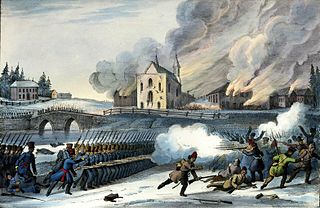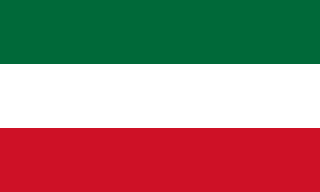Related Research Articles

The Lower Canada Rebellion, commonly referred to as the Patriots' War in French, is the name given to the armed conflict in 1837–38 between rebels and the colonial government of Lower Canada. Together with the simultaneous rebellion in the neighbouring colony of Upper Canada, it formed the Rebellions of 1837–38.

Sir Étienne-Paschal Taché was a Canadien doctor, politician, and Father of Confederation. His family had a long history in New France, but suffered serious financial reverses due to the Seven Years' War and the siege of Quebec. He was considered a self-made man, who became a physician, a militia soldier, and a politician. He served twice as joint premier of the Province of Canada.

The Rebellions of 1837–1838, were two armed uprisings that took place in Lower and Upper Canada in 1837 and 1838. Both rebellions were motivated by frustrations with lack of political reform. A key shared goal was responsible government, which was eventually achieved in the incidents' aftermath. The rebellions led directly to Lord Durham's Report on the Affairs of British North America and to the Act of Union 1840 which partially reformed the British provinces into a unitary system and eventually led to the British North America Act, 1867, which created the contemporary Canadian federation and its government.

This section of the Timeline of Quebec history concerns the events in British North America relating to what is the present day province of Quebec, Canada between the time of the Constitutional Act of 1791 and the Act of Union 1840.
The Société des Fils de la Liberté was a paramilitary organization founded in August 1837 in Lower Canada.

The British North America Act, 1840, also known as the Act of Union 1840, was approved by Parliament in July 1840 and proclaimed February 10, 1841, in Montreal. It abolished the legislatures of Lower Canada and Upper Canada and established a new political entity, the Province of Canada to replace them.

Wolfred Nelson was the mayor of Montreal, Quebec, from 1854 to 1856.

Events from the year 1837 in Canada.

Ludger Duvernay, born in Verchères, Quebec, was a printer by profession and published a number of newspapers including the Gazette des Trois-Rivières, the first newspaper in Lower Canada outside of Quebec City and Montreal, and also La Minerve, which supported the Parti patriote and Louis-Joseph Papineau in the years leading up to the Lower Canada Rebellion.

Field Marshal John Colborne, 1st Baron Seaton, was a British Army officer and colonial governor. After taking part as a junior officer in the Anglo-Russian invasion of Holland, Sir Ralph Abercromby's expedition to Egypt and then the War of the Third Coalition, he served as military secretary to Sir John Moore at the Battle of Corunna. He then commanded the 2nd Battalion of the 66th Regiment of Foot and, later, the 52nd Regiment of Foot at many of the battles of the Peninsular War. At the Battle of Waterloo, Colborne on his own initiative brought the 52nd Regiment of Foot forward, took up a flanking position in relation to the French Imperial Guard and then, after firing repeated volleys into their flank, charged at the Guard so driving them back in disorder.

National Patriots' Day is a statutory holiday observed annually in the Canadian province of Quebec, on the Monday preceding 25 May. The holiday was established by the Lieutenant Governor of Quebec-in-Council in 2003, according to the Parti Quebecois premier Bernard Landry: "to underline the importance of the struggle of the patriots of 1837–1838 for the national recognition of our people, for its political liberty and to obtain a democratic system of government." Before 2003, the Monday preceding 25 May of each year was unofficially the Fête de Dollard, a commemoration initiated in the 1920s to coincide with Victoria Day, a federal holiday occurring annually on the same date.

Thomas Storrow Brown was a Canadian journalist, writer, orator, and revolutionary in Lower Canada.

The Battle of Saint-Denis was fought on November 23, 1837, between British colonial authorities under Lieutenant-Colonel Gore and Patriote rebels in Lower Canada as part of the Lower Canada Rebellion. The Patriotes were led by Wolfred Nelson. Gore was sent to quell the uprising in the Richelieu River valley in conjunction with a force led by Lieutenant-Colonel George Wetherall. Gore was the first to arrive at a Patriote-held site. Nelson had organized the defence with most of the well-armed rebels within a stone house that overlooked the road. Gore, accompanied by only one cannon, attempted to take the stone house three times, with the cannon providing ineffective fire. Another attempt to flank the house to the left failed when Gore's soldiers encountered the less well-armed militia. Running out of ammunition, the British retreated. This marked the only Patriote victory in 1837, as this battle was followed by two defeats at Saint-Charles and Saint-Eustache.

The Battle of Saint-Charles was fought on 25 November 1837 between the Government of Lower Canada, supported by the United Kingdom, and Patriote rebels. Following the opening Patriote victory of the Lower Canada Rebellion at the Battle of Saint-Denis, British troops under the command of Lieutenant Colonel George Wetherall advanced from the south on the Patriote stronghold of Saint-Charles in the Richelieu valley. On 25 November 1837 they engaged the Patriote forces under the command of Thomas Storrow Brown. After a two-hour battle, the Government of Lower Canada was victorious.
Amable Berthelot was a Canadien lawyer, author and political figure. He was elected to the Legislative Assembly of Lower Canada and later to the Legislative Assembly of the Province of Canada. Trained as a lawyer, he was an avid book-collector, at one point having a personal library of some fifteen hundred volumes. He did not support those who took up arms during the Lower Canada Rebellion of 1837–1838. He never married, but adopted two children, a boy and a girl. His daughter married Louis-Hippolyte LaFontaine, later co-premier of the Province of Canada. He was a literary mentor to François-Xavier Garneau.

The Assembly of the Six Counties was an assembly of Patriote leaders and approximately 6,000 followers held in Saint-Charles, Lower Canada on October 23 and October 24, 1837, despite the June 15 Proclamation of the government forbidding public assemblies.

The patriotes movement was a political movement that existed in Lower Canada from the turn of the 19th century to the Patriote Rebellion of 1837 and 1838 and the subsequent Act of Union of 1840. The partisan embodiment of the movement was the Parti patriote, which held many seats in the Legislative Assembly of Lower Canada.

The Patriote flag was used by the Patriote movement in Lower Canada between 1832 and 1838.
The Iroquois community of Kahnawake played a unique role in the Lower Canada Rebellions, part of the greater Rebellions of 1837.
The following is an incomplete bibliography of the 1837-1838 insurrections in Lower Canada in the English and French languages, by publication date and document type.
References
This article includes a list of references, related reading, or external links, but its sources remain unclear because it lacks inline citations .(January 2015) |
- "Le Doric Club" at Les Patriotes de 1837@1838
- Les adversaires des Patriotes by Pierre Lapointe, Les Éditions à Mains Nues inc., ISBN 2-89275-111-X